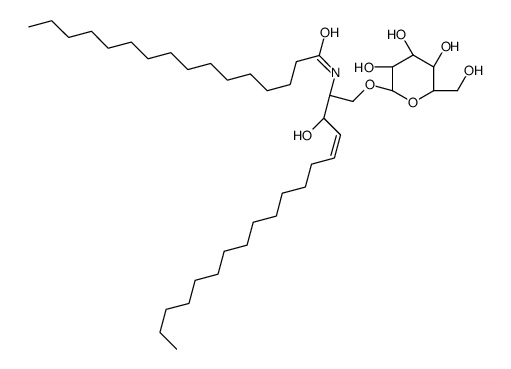Psychosine

Psychosine structure
|
Common Name | Psychosine | ||
|---|---|---|---|---|
| CAS Number | 2238-90-6 | Molecular Weight | 461.63200 | |
| Density | 1.14 g/cm3 | Boiling Point | 664.3ºC | |
| Molecular Formula | C24H47NO7 | Melting Point | N/A | |
| MSDS | Chinese USA | Flash Point | 355.6ºC | |
| Symbol |

GHS07 |
Signal Word | Warning | |
Use of PsychosinePsychosine (Galactosylsphingosine), a substrate of the galactocerebrosidase (GALC) enzyme, is a potential biomarker for Krabbe disease[1]. Psychosine is a highly cytotoxic lipid, capable of inducing cell death in a wide variety of cell types including, most relevantly to globoid cell leukodystrophy (GLD), oligodendrocytes. Psychosine causes cell death at least in part via apoptosis. Psychosine also is an inhibitor of PKC[1]. |
| Name | psychosine |
|---|---|
| Synonym | More Synonyms |
| Description | Psychosine (Galactosylsphingosine), a substrate of the galactocerebrosidase (GALC) enzyme, is a potential biomarker for Krabbe disease[1]. Psychosine is a highly cytotoxic lipid, capable of inducing cell death in a wide variety of cell types including, most relevantly to globoid cell leukodystrophy (GLD), oligodendrocytes. Psychosine causes cell death at least in part via apoptosis. Psychosine also is an inhibitor of PKC[1]. |
|---|---|
| Related Catalog | |
| Target |
PKC |
| In Vitro | Psychosine, is a substrate of the GALC enzyme that shows promise to aid in the diagnosis and follow-up of at-risk infants identified through newborn screening (NBS)[1]. Psychosine induces pleiotropic effects, including dysfunctions in several cellular pathways[2]. Cell Viability Assay[2] Cell Line: Oligodendrocyte cells, M03.13 Concentration: 10, 20, and 40 μM Incubation Time: 24 hours Result: Caused cell death at least in part via apoptosis. |
| References |
| Density | 1.14 g/cm3 |
|---|---|
| Boiling Point | 664.3ºC |
| Molecular Formula | C24H47NO7 |
| Molecular Weight | 461.63200 |
| Flash Point | 355.6ºC |
| Exact Mass | 461.33500 |
| PSA | 145.63000 |
| LogP | 2.44870 |
| Vapour Pressure | 1.77E-20mmHg at 25°C |
| Index of Refraction | 1.535 |
| Storage condition | −20°C |
| Symbol |

GHS07 |
|---|---|
| Signal Word | Warning |
| Hazard Statements | H302-H312-H332 |
| Precautionary Statements | P280 |
| Personal Protective Equipment | dust mask type N95 (US);Eyeshields;Gloves |
| Hazard Codes | Xn: Harmful; |
| Risk Phrases | R20/21/22 |
| Safety Phrases | 36 |
| RIDADR | NONH for all modes of transport |
| Precursor 0 | |
|---|---|
| DownStream 3 | |
|
How well does urinary lyso-Gb3 function as a biomarker in Fabry disease?
Clin. Chim. Acta 411(23-24) , 1906-14, (2010) Fabry disease is characterized by accumulation of glycosphingolipids, such as globotriaosylceramide (Gb(3)), in many tissues and body fluids. A novel plasma biomarker, globotriaosylsphingosine (lyso-G... |
|
|
Aberrant production of tenascin-C in globoid cell leukodystrophy alters psychosine-induced microglial functions.
J. Neuropathol. Exp. Neurol. 73(10) , 964-74, (2014) Globoid cell leukodystrophy (GLD), or Krabbe disease, is a rare and often fatal demyelinating disease caused by mutations in the galactocerebrosidase (galc) gene that result in accumulation of galacto... |
|
|
Bone marrow transplantation augments the effect of brain- and spinal cord-directed adeno-associated virus 2/5 gene therapy by altering inflammation in the murine model of globoid-cell leukodystrophy.
J. Neurosci. 31(27) , 9945-57, (2011) Globoid-cell leukodystrophy (GLD) is an inherited demyelinating disease caused by the deficiency of the lysosomal enzyme galactosylceramidase (GALC). A previous study in the murine model of GLD (twitc... |
| Galactosylsphingosine |
| D-galactosyl-ß1-1'-D-erythro-sphingosine |
| 1-B-D-GALACTOSYLSPHINOGOSINE |
| Psychosine from bovine brain |
| PSYCHOSIN |
| PSYCHOSINE |
| D-GALACTOSYL-B1-1' SPHINGOSN |
| LYSO-CERAMIDEGALACTOSIDE |
| MFCD00057505 |
| O-Galactosylsphingosine |
| LYSO-CEREBROSIDE |
 CAS#:34324-89-5
CAS#:34324-89-5 CAS#:17283-91-9
CAS#:17283-91-9 CAS#:73039-25-5
CAS#:73039-25-5